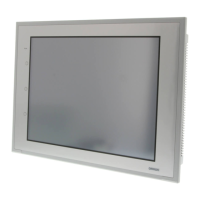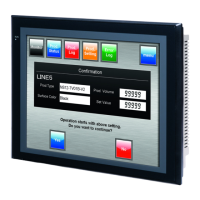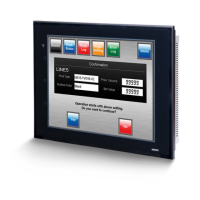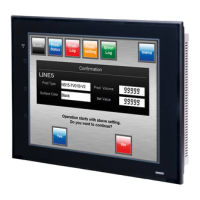3-1 Installing the PT
3-5
2. Secure the panel mounting brackets from the back of the panel, as shown in the following
diagram.
Insert the catch on each bracket into the square hole on the PT, and secure the PT to the
panel by tightening the screws with a Phillips screwdriver while gently pulling in the PT.
Note • Do not allow metal particles to enter the PT while work is being performed on the panel.
• The allowable thickness of the panel for mounting is between 1.6 and 4.8 mm.
Secure the mounting bracket with a uniform tightening torque of between 0.5 and 0.6 N⋅m
to keep the PT waterproof and dustproof.
The front sheet may become distorted if the tightening torque is more than the specified
limit or not uniform. Always use a panel that is clean, undistorted, and strong enough to
adequately withstand mounting the PT.
Conformance to Shipbuilding Standards
• Cover the entire surface of the PT with EMI-shielding material and ground the EMI-
shielding material using conductive tape, such as copper tape, to the control panel or op-
eration panel.
Recommended electromagnetic shielding: E09F100, E09R13502P
Manufacturer: SEIWA ELECTRIC MFG, Co., Ltd.
Electromagnetic shielding reduces the permeability by approximately 50%.
• Completely cover gaps and openings between the PT and the control panel and operation
panel with gaskets or other materials.
• Completely cover gaps between the PT and the panel cutout with conductive tape, such as
copper tape, and then secure the PT using mounting brackets.
• To suppress noise terminal voltage, install the PT under the following conditions.
NS5-V2 Series
We recommend attaching a filter to the DC power supply line.
Recommended filter: MR-2043 or equivalent
Manufacturer: TOKIN
NS12/10/8-V2 Series
We recommend using the following product for the DC power supply.
Recommended power supply: S82K-03024
Manufacturer: OMRON
3-1-4 Connecting the Power Supply
Connect a 24-VDC power supply to the power input terminals.
Note • Do not connect an AC power supply to the power terminals.
• Use a DC power supply with low voltage fluctuation.
• Do not perform a dielectric strength test.
• Use a DC power supply that will provide a stable output even if the input is momentarily
interrupted for 10 ms, and which has reinforced or double insulation.
• Power Supply
The following table shows the specifications for the power supply that can be connected. De-
termine power supply specifications that meet the power supply capacity requirements.
